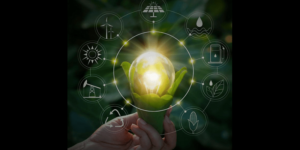The world is at a watershed moment when it comes to climate change. The 2021 report from Deloitte Global on Climate Check indicates that all major organizations worldwide have started feeling its negative impacts (1).
Global companies and even SMEs, small and medium-sized enterprises have increasingly started to assess and communicate the impact of their operations, value chains, and products on society and the environment, pushed by consumers and investors. Businesses have started taking concrete actions to lessen their environmental impacts and enhance their positive contributions to help fight climate change.
With several companies reducing their emissions and commercializing carbon-neutral products, the next challenge is to tackle the other side of the coin. It is time we evaluate how climate change, policy interventions, and efforts to mitigate climate change impacts will affect businesses (2).
Read Also: Solarpunk: An Intriguing, Optimistic Subculture on the Rise
What is Climate Change?
In simple terms, climate change is the direct outcome of global warming.
The discovery of global warming dates back to the 19th century when a Nobel prized chemist and physician from Sweden, Svante Arrhenius, outlined his theory. Arrhenius stated in his theory that CO2 (the greenhouse effect) impacts climate patterns that can cause climate change. The hazards include depletion of the ozone layer, ocean acidification, ice melting, rising sea level, desertification, and biodiversity loss.
Since then, the awareness that human activities influence climate and have anthropogenic effects has increased significantly (3).
Global warming causes can include fossil fuel burning(responsible for 75.2% of greenhouse gas emissions), electricity and heating consumptions (32.6%), and the transport industry (14.2%). The rise in N2O and Ch4 are primarily linked to the animal farming industry (16.1%), meaning that climate change and meat consumption are intimately related (4).
To curb a catastrophic evolution by the phenomenon, we need to focus on reducing our CO2 emissions as much as possible.
Read Also: Reliance’s Green Energy Push Could be a Game-Changer
Climate Change Impacts and Indicators Worsened in 2020
World Meteorological Organization published a report in April 2021 (5), documenting that 2020 was one of the three warmest years on Earth’s record despite the cooling event (6). The average temperature worldwide was about 1.2 degrees Celsius above the pre-industrial (1859 to 1900) level.
“All key climate indicators and associated impact information in the report highlight relentless, continuing climate change, a rising occurrence and intensification of extreme events, and severe losses and damages that affect societies and economies. The negative trend in climate will continue for decades, independent of our success in mitigation. Hence, it is important to invest in adaptation,” said Prof. Petteri Taalas, WMO Secretary-General (7).

“The report highlights that we have no time to waste. Our climate is changing, and its impacts are too expensive for people and the planet. It is time to take action. Nations worldwide need to commit to net zero emissions by 2050, And they need to act now to protect people against disastrous effects of climate change,” António Guterres, the United Nations Secretary-General (8).
In 2020, the COVID-19 pandemic had added a new and unwelcomed dimension to climate, weather, and water-related hazards with wide-ranging combined impacts on human health and well-being.
The pandemic and associated economic downturns, mobility restrictions, disruptions in agriculture sectors worsened the effects of climate events and extreme weather. It has also led to a disruption of the entire food supply chain, elevated food insecurity levels, slowed down humanitarian assistance deliveries, weather observation, and complicated disaster risk reduction efforts.
Yet, the current global disruptions caused by the pandemic presents opportunities to set our economies on a greener path. It is time we boost investment in green and resilient public infrastructure, which would support employment and GDP during the recovery period.
We can also place adaptation policies to enhance resilience to climate change. It can include investments in early warning systems, disaster-proof infrastructure, risk-sharing via financial markets, and the development of social safety nets to limit the impact of climate change-related shocks while helping economies recover faster.
Read Also: Soaring Eco-Friendly Trend is Paving Infinite Ways for Entrepreneurs to Capitalize
Climate-Related Risks for Businesses
The world had been delaying fighting against the Earth’s fever for a long time. And it has two important effects:
- Despite the world’s emission reduction efforts, we can no longer avoid climate change impacts.
- The delay has led many countries to accelerate themselves to prevent disastrous outcounts. Meaning, we can expect to see policy interventions like new subsidies for green energy and low-carbon technologies, carbon taces, compulsory energy efficiency, etc., in the upcoming years.
There is no doubt that both consequences have a far-reaching impact on businesses’ long-term resilience and profitability.
Businesses, especially those that depend highly on natural and climate resources, will need to adapt to new environmental conditions and frequent extreme weather events. Moreover, businesses will also need to increase their operational or investment costs to comply with new regulations. And it leads us to different types of climate-related risks companies face.
Read Also: The Lucrative Market for Refurbished Products
Types of Climate Change-Related Risks
Many new terminologies have emerged in the past few years to explain the different climate-change-related risks that companies face.
- Physical risks: These risks are in direct relation to climate change impacts like hurricanes or floods destroying a production plant or climate variability affecting crop production.
- Transition risks: These risks are linked to expected policy changes for moving towards a low-carbon economy.
- Reputational risks: Well, they are not new for businesses, but they are being associated with insufficient action in curbing greenhouse gas emissions at an increased pace.
Besides these three major categories, another important factor for businesses includes access to finance. It is also becoming increasingly linked to climate-related risks because financial institutes are exposed to it due to their investees’ and clients’ climate-related risks.
It means that if governments decide to pass their ambitious laws to accelerate the transition towards a low-carbon economy, carbon-intensive businesses will incur higher costs. It may prevent them from repaying their debt, which would, in turn, weaken the balance sheets of banks.
As a result, financial regulators worldwide are taking actions to mandate climate-related risks disclosure by supervised institutions as a first critical step to keep them under control.
In addition, banks can also face reputational risks if their loans and asset portfolios are too focused on carbon-intensive activities, Credit Suisse, for instance (9, 10). It seems to explain why many major banks have started to revise their credit and investment guidelines away from carbon-intensive assets and clients.
Activists in dinghy urge Credit Suisse off climate ‘collision course’ https://t.co/QkWCO0Vydm pic.twitter.com/OUtFm8ioOr
— Reuters (@Reuters) February 15, 2020
The scenario is similar on the equity end as well. Investors active in financial markets are considering the risk of new climate-related laws. They have also started considering companies with high ESG, environmental, social, and governance performance more promising than low ESG ones.
In addition, several asset managers have started responding to their clients’ rising sustainability concerns. Hence the demand for carbon-intensive assets has also started becoming more volatile (11).
There are also liability risks that derive from neglecting climate-related risks in the investment choices of institutional investors like pension funds. Therefore, companies with poor ESG performance or high climate-related risks may find it challenging to raise capital.
Read Also: Sustainable Agriculture and The Next Green Revolution
Sectors Most Exposed to Climate-Related Risks
For businesses in many sectors, climate-related risks depend on:
- Industry
- Production location
- Company assets
- Carbon footprint
Physical risks affect businesses whose productions depend on climatic conditions or the sufficient and predictable availability of natural resources. Examples include the food and beverage sector, hydroelectric power generation, and winter tourism.
Apart from the type of economic activity, the location of production and physical assets is also a crucial element for assessing physical risks. After all, even though climate change affects the entire planet, the type and magnitude of impacts are location-specific. For example, some areas are more prone to hurricanes while others are to droughts (12, 13).
It is also worth noting that physical risks may also be significant even for carbon-neutral companies. One good example is hydroelectric power generation plants because of unpredictable rainfall, heavy rains causing more debris in water basins, and prolonged dry periods.
Physical risks also result from extreme wealth events and climate-change-related natural disasters. For instance, Pacific Gas and Electric Company in California became the first company to file for bankruptcy in 2019 due to climate change. Wildfires swept its service area because of extremely dry and hot conditions, which caused liabilities of more than 30 billion USD (14).
Another example includes Australia’s bushfires that damaged businesses in many sectors (15).
“Many companies are reporting hits to businesses as Australia’s deadly bushfires rage. Resorts are closing their doors, insurance claims are on the rise, and cheesemakers are struggling to procure milk supplies,” reported Reuters in January 2020 (16).
However, companies’ damage doesn’t include the biggest loss from such catastrophic manifestation of climate change: habitats and wildlife. According to scientists, it can have negative consequences for humans, including the increased risk of pandemics (17).
On the other hand, businesses associated with transition risks are easy to find since they are directly linked to a company’s exposure to the fossil fuel supply chain and the resultant carbon footprint. It can include utilities, transport, manufacturing, mining, and construction.
In addition, businesses in these sectors are also at an increased reputational risk if they delay the adoption of existing economically-viable low-carbon-footprint technologies.
“These sectors have faxed huge stakeholder activism around climate disclosures. Actions like lawsuits and shareholder resolutions related to climate risk have been directed towards the largest organizations worldwide within these sectors,” says professional services firm Ernst and Young (18).
Transition risks have become a bigger concern within the financial sector than physical ones. It may be because of relative methodological simplicity in estimating transition risks and the expectation that they manifest themselves before physical ones. After all, financial institutes are expecting new climate-related regulations soon in most countries. And there is also the fact that unmanaged transition risks can amplify reputational risks.
Nonetheless, we can expect to see physical risks coming under the radar of major financial institutions, especially in crucial business lines like mortgages or loans in climate-sensitive sectors. Also, physical risks are relevant for other financial actors like asset managers, insurers, and investors (19).
Read Also: Waste Industry: Innovations and Business Opportunities
There are Opportunities Too
When businesses understand climate-related risks before they start to materialize, it will allow them to plan, finance, and implement risks management strategies at low costs. Compared to a wait-and-watch strategy, it also led to higher reputation-related returns and overall long-term benefits in terms of business resilience and profitability.

In other words, a blooming green finance sector offers multiple opportunities to mitigate transition risks and provide better models to manage physical risks.
Remember, good risk management starts with a good risk assessment. Companies need to find and assess these new types of climate-related risks and their value chains. It will help them act better to decrease the probability of liquidity issues or losses in years to come because of compromised fiance access, complying with new regulations, or damage costs because of climate-change-related natural disasters.
Businesses that help industrial sectors to utilize their resources and implement a credible strategy to reduce their carbon footprints can win big.
Investments in climate-friendly companies are skyrocketing; there is also a reduction of loan exposure in these sectors.
There is also room for growth for entrepreneurs who can help companies divest from high-carbon assets. There are two ways to do it, either reduce their short-term profit margins and make massive investments in low-carbon technologies or take an opportunity to rethink their core business.
Of course, applications of these models to business uses are still in a nascent stage. However, we can expect this industry to skyrocket in the upcoming years.
In short, businesses that can help companies decide which investments make more sense, set up new sustainable facilities, and protect their assets from climate change-related natural disasters, whether through infrastructure or insurance, are set to win big. We also see opportunities in helping financial institutes to set up systems to help them assess and manage their credit risk in their investment portfolios.
Read Also: Plant-Based Protein is Coming of Age in India
Closing Remarks
We have always emphasized businesses focus on sustainability since it is among the top consumer trends. However, seeing the fatal effect of climate change on businesses, we need to change our narrative.
Businesses need to focus on sustainability and saving their planet not only because their customers care. It is time businesses think about the disastrous effect of climate change on businesses and the world economy. It is time for businesses to convert their concerns into actions!
Remember, the business landscape is always changing, and it changes fast. New risks and opportunities have started becoming increasingly linked to our planet’s health. As it has always been, there will be both winners and losers. And you will have bigger chances of prospering in the upcoming decades if you embrace climate risk assessments and management today.









